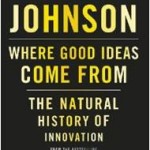Editor’s Note: This blog post was originally published on Read Write Web, a popular technology blog. I have been meaning to put together a short series of posts summarizing Steven Johnson’s “Where Good Ideas Come From,” for the Innovation Exchange – and well I was beat to the punch. In the spirit of not recreating the wheel and sharing good ideas I would like to present this well written post by Dan Rowinski. Stay tuned for more in depth discussions on Johnson’s theories on the origin of good ideas.
Chance favors the connected mind. That is what author Steven B. Johnson says to those looking for the next big idea. Johnson is the author of ” Where Good Ideas Come From” a book that looks at the macro trends on how innovation evolves. 
Ideas are rarely created through a “eureka” moment. It may seem like Doc Brown fell off his toilet and invented the flux capacitor, but really the idea for time travel and how to do it were converging in his brain for quite some time before the blow tothe head. Instead of an “aha!” moment, Johnson believes that ideas are born of a “slow hunch” that are made possible through periods of technological innovation and evolution. If you are creating a startup, where do you get your ideas from?
Innovation is often made possible by the evolution of networked possibilities. In a presentation at Google Innovation Nation in Washington, D.C. on Thursday, Johnson used the example of John Snow and cholera outbreaks in London during the mid-19th century. Johnson used data being about deaths being made available by the London government for the first time, empirical observation and his own background of studying water to come to the conclusion that cholera was not being spread through the air but rather by a water pump in a local neighborhood. Snow created a spot-map of where cholera deaths were reported from the statistics he obtained and honed in on the center of the outbreak.

That sounds familiar – taking data and mapping it to suit your mission and illuminate theories or facts. Essentially, anybody can do that now with GIS software and an .xml data set. The Centers for Disease Control use mapping to determine outbreaks and recently Google released its Google Flu Trends that accumulates flu data throughout the season. Yet, it was not Snow’s own genius that came up with the solution to the cholera outbreak (disputed at the time) but rather a set of groups in various sectors using their collective intelligence to solve a problem.
The Hive Mind & Collective Intelligence
“It is just this idea that if you diversify and have an electric range of interests and you are constantly getting interesting stories about things that you do not know that much about or are adjacent to your particular field of expertise you are much more likely to come up with innovative ideas,” Johnson told ReadWriteWeb.
The same approach would work well for developers and innovators working on the next technology breakthrough. Startup founders should take step back from their project and ask what type of similar projects have been undertaken in a completely different field and see if those lessons can be applied to their project.
“The trick is to look at something different and borrow ideas. It is like saying ‘this worked for that field, if we put it here what would it do in this new context?'” Johnson said.
In today’s world, the ability to branch out of your field of expertise has been made much easier through social media. You can follow what is happening in your niche through a specifically created Twitter list, but it is also beneficial to create lists of people working in different sectors as well.
“The important thing is that this is not some kind of hive-mind wisdom of the crowds, collective intelligence network smarts,” Johnson said. “The unit is still the individual or the small group. There are some examples of group intelligence. This is an example instead of taking individuals in small groups and making them smarter by connecting them to a wider range of influences.”


